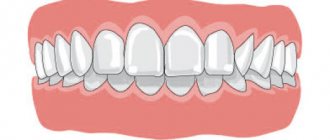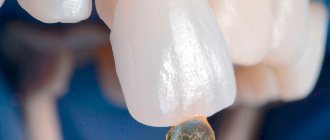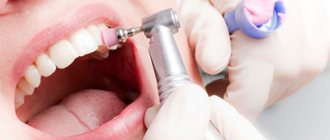Problem: “tetracycline teeth”
“Tetracycline teeth” is a characteristic of discoloration of enamel as a result of taking an antibiotic called tetracycline.
It is used to treat acute diseases caused by various bacteria. For example, pneumonia, acne, anthrax, cholera and so on. Moreover, tooth staining occurs regardless of whether the child himself took the drug, was in the mother’s stomach, or was fed breast milk. The active substances are deposited not only in the dental tissues, but also in the bone structure of the child. The most dangerous thing is that not only the outer enamel of the teeth is stained, but also the inner layer - this explains the difficulty of restoring the whiteness of the dentition.
Not the entire tooth may become stained, but only part of it, depending on which part of the tooth was formed when taking the antibiotic.
Tetracycline teeth: where does this color come from?
Tetracycline is included in a fairly large number of drugs, both external and internal use. Basically, such drugs are used to treat various types of skin rashes and inflammations, but only in the 80s the effects of tetracycline drugs on teeth began to be studied, as doctors paid attention to changes in enamel color.
When tetracycline drugs are taken in large quantities, it can subsequently be deposited in the bones along with calcium and manifest itself in the color of the enamel.
Pregnant women and children are most susceptible to this process - they are prohibited from taking tetracycline drugs. During the period of formation and growth of teeth - and it begins in the mother's womb - such accumulation most likely leads to the formation of tetracycline enamel, and the longer the expectant mother took the antibiotic, the brighter and more intense the color of the teeth will be.
Tetracycline should not be taken by children under 12 years of age - during this period, permanent teeth are formed, and fragile enamel and bone tissue will turn that same grayish-yellow shade.
Of course, the likelihood of staining is influenced by many factors - the duration of use, individual and allergic reactions of the body, and diet... However, the fact remains: it is better not to take risks and wait with taking tetracycline antibiotics until the permanent teeth are completely will not form and strengthen.
Expert opinion
Roman Borisovich Alekperov
orthopedic dentist
Experience: 24 years
Today there are various ways to solve the problem of tetracycline teeth. Starting from ceramic veneering to covering teeth with crowns. In any case, you can choose an option that suits your budget. Don’t waste time, get your teeth in order, and get rid of aesthetic problems and psychological discomfort that this dental pathology causes.
Types of medications and possible oral side effects
Antibiotics
Antibiotics of all groups lead to dry mouth, proliferation of pathogenic microflora, increase the risk of bleeding gums, demineralization of enamel and the development of caries. Taking penicillins and macrolides can cause changes in taste sensations during meals, causing bitterness and a metallic taste in the mouth.
Drugs that include erythromycin can contribute to the development of gum hyperplasia (gum overgrowth). Medicines containing tetracycline lead not only to a change in the color of the teeth themselves, but also in the shade of the mucous membrane. Amoxicillin and clavulanic acid can also change the color of the tongue - it turns black, which makes many suspect that they have a type of glossitis called black hairy tongue.
Glucocorticoids provoke an exacerbation of chronic processes in the oral cavity that have not been cured and have been sluggish for a long time.
Expert opinion
Elena Vladimirovna Orlova
Specializations: Dentist-therapist, endodontist
Experience: 33+
“Any medications, including antibiotics, are necessary to fight various pathologies, but all of them, without exception, are potentially dangerous and can cause harm if used uncontrolled. To minimize risks, you must take any medications only in consultation with your doctor and strictly according to the instructions. After taking it, it is recommended to take medications containing probiotics, which have a positive effect on the microflora of the intestines and oral cavity.”
Other groups of drugs
In this section of the article we should talk not only about antibiotics, but also about other drugs, the abuse of which can lead to unpleasant consequences:
- non-steroidal anti-inflammatory drugs: loss of taste sensitivity, development of stomatitis,
- immunostimulants: in some cases they can activate the herpes virus in the body, leading to the development of fungal infections,
- topical antiseptics: for example, chlorhexidine and triclosan, lead not only to the destruction of bacteria that cause inflammation, but also to the neutralization of normal lactic acid flora. Abuse of these drugs can lead to worsening of the underlying disease. That is, at first there really is relief, and then the person wonders why the deterioration began. Plus, chlorhexidine also causes yellowing of the enamel,
- antimicrobial drugs, cough syrups and lozenges: many of them contain sweeteners that are detrimental to the integrity of the enamel, leading to the proliferation of harmful bacteria, demineralization of hard tissues, the development of caries,
- hormonal agents: disrupt mineral metabolism, lead to a deficiency of fluoride and calcium, which affects the strength of the enamel and reduces its resistance to bacteria. May cause bleeding gums,
- diuretics: they lead to the leaching of calcium from the body, in rare cases they can cause the development of stomatitis,
- contraceptives: weaken periodontal tissues, cause inflammation of the gums, contribute to the appearance of ulcers on them,
- products containing aspirin and painkillers: corrode enamel, provoke erosion, irritate soft tissues and cause bleeding,
- drugs for weight loss: reduce salivation, increase the risk of caries,
- Heartburn medications: Reduce calcium absorption, increase the risk of bone fractures and thin tooth enamel. In addition, scientists from McGill University conducted a study, during which it was found that frequent use of such medications can affect the survival rate of dental implants in a negative way.
“I once took iron supplements, not as directed by the doctor. They only partially solved my problem, but added new troubles: my teeth became brown, and a metallic taste appeared in my mouth. I was scared. But I was very young then, how could I smile?!! I went to the doctors. The therapist told me not to take any more medications on my own, much less antibiotics. With brown color, naturally, I had to see a dentist. We had a cleaning at the dentist. Everything seemed to have gone away, but I suffered through fear while I thought that brown enamel was forever. I got off relatively lightly, but since then I’ve never prescribed anything for myself on my own and I don’t recommend it to anyone.”
V.A., review from 32top.ru
It is important to remember that antibiotics and many medications in general have a number of other side effects that manifest themselves not only in the oral cavity, but also affect the entire body as a whole. They can cause nausea, drowsiness, headaches, confusion and disruption of the gastrointestinal tract, allergies. The more uncontrolled their use, the higher the risk of developing pathologies.
Solution
Option 1: Teeth whitening. If teeth have a slight and uniform discoloration, regular whitening will be effective. For example, using ZOOM 3 technology. As a result of a simple procedure, it is possible to change the color of teeth by 8-12 shades and achieve the preservation of the result for several years. In addition, whitening is quite safe for teeth and allows you to change the shade of enamel even on sensitive teeth. Read more>
Option 2: Prosthetics with veneers. However, in most cases, teeth whitening will not achieve 100% white enamel. In case of obvious staining of teeth, the only effective method of restoring a smile is microprosthetics with veneers. Veneers are thin overlays that are fixed to the front part of the tooth. They allow you to hide all visible imperfections - dark spots, chips and cracks, as well as gaps between teeth and even minor changes in the position of the teeth. Outwardly, they resemble dental lenses and serve to create ideal dental aesthetics. Veneers are created individually and the patient will be able to choose not only the shape, but also the color of future teeth. Read more>
Causes of yellow plaque on teeth
Example of yellow teeth and whitening
A number of different factors lead to the appearance of yellow plaque on teeth. These include:
- smoking;
- daily consumption of coffee and tea;
- lack of proper oral hygiene;
- aging;
- illness;
- heredity…
Yellow plaque on teeth can also form due to improper metabolism, certain climatic conditions, or even from the use of antibiotics (some can cause tooth discoloration).
It is generally accepted that regular teeth brushing is a good and effective remedy for yellow teeth! Unfortunately, this is not entirely true! Yellow plaque can also appear in people who brush their teeth regularly!
If you are concerned about permanent yellow plaque on your teeth, we have prepared for you a number of tips and tricks to remove plaque on your teeth at home.
Professional whitening methods
The dental practice is equipped with the latest equipment, allowing for effective and gentle teeth whitening. Here are the most popular methods:
- Ultrasound teeth cleaning. This removes soft dental deposits. During the procedure, a special device with tips is used, which, in addition to plaque, also removes stones. Finally, the teeth are polished with protective pastes.
- Laser whitening. The tooth is coated with a special gel, then the specialist acts on it with a laser. Each tooth is processed for 1-2 minutes.
- Air Flow technology. Its essence lies in the fact that tooth enamel acquires natural whiteness due to exposure of the tooth surface to fine powder based on soda and silicon dioxide.
Separately, it is worth mentioning photo teeth whitening or the ZOOM whitening system. The method is based on coating the teeth with a special gel containing hydrogen peroxide. Under the influence of ultraviolet radiation, peroxide decomposes and coloring substances are removed from the enamel with the help of the resulting oxygen. Unlike other whitening procedures, photobleaching takes less time and allows you to change the shade of the enamel by several tones at once. That is why patients often choose this method.
During professional whitening, teeth remain intact and the results last for many years.
As you can see, yellow plaque on teeth is not a problem today. The main thing is to contact a specialist who can choose the optimal whitening method to effectively deal with the most difficult case. As a result, your teeth will be snow-white and the dream of a Hollywood smile will come true!











